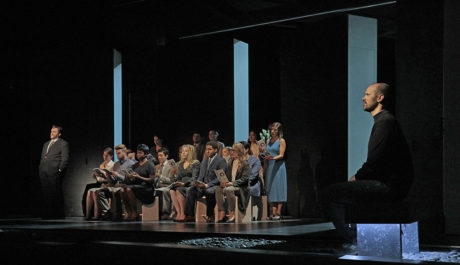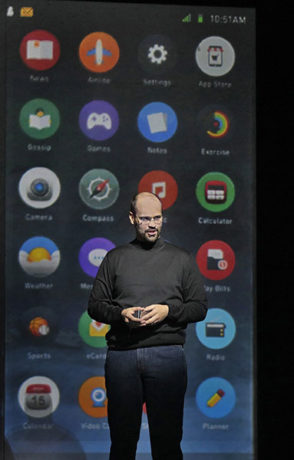Steve Jobs was a revolutionary genius in communicating. He showed the world how to get “everything” anyone needed on a single gadget. Yet he was a spectacular failure in communicating with his friends and family on a personal level.
That’s the essence of his story, and it contains basic conflict, which is the stuff of drama. Yet Steve Jobs has been an elusive subject, as proven by the failure of two motion picture attempts. So the choice of Jobs’ life for an opera was no slam dunk.

The composer Mason Bates was drawn to the subject because of his own interest in technology. He is a deejay and a creator of electronic soundscapes. Then he turned to classical compositions that utilized keyboard samplings of sounds and other electronica.
To date, his biggest success has been Alternative Energy, commissioned and premiered by Riccardo Muti and the Chicago Symphony and performed this past season by Yannick Nézet-Séguin and the Philadelphia Orchestra. It presents a sound representing the crank which Henry Ford used to start his automobiles and proceeds to the sounds of nuclear reactors and of icebergs melting and breaking apart because of global warming. All of this is within the instrumental palette of a symphony orchestra.
Bates sits in the orchestra with his own computer and other electronic devices at performances of Alternative Energy and of this new opera.
Knowing that the personality of Jobs presented problems, Bates sought out Mark Campbell, the librettist of the acclaimed opera Silent Night and of Broadway shows, to be his creative partner. Campbell chose to present a seemingly-random group of episodic anecdotes to build a narrative that is more personal than the general perception of Jobs. It does not whitewash his faults; we see him being self-centered, obsessive, demanding, and cruel.
We also witness his early years when he and Steve Wozniak horsed around and found a way to break into Ma Bell. They joyously sing about bringing that behemoth “to its knees…money-sucking, monolithic, monopolistic, autocratic Ma Bell was just screwed over.”

Their pleasure in being outsiders presents a contrast with the Jobs who barks orders and insults and dismisses his co-workers, and even Woz. Woz has a big aria in which he sings, “The guy I thought I knew / Has no time / No Space / No life. You’re losing it.”
We finally see Jobs marry the lovingly devoted Laurene Powell, who eventually convinces Jobs to slow down, look inward and seek medical help.
Bates assigns specific sounds to his various characters. Jobs is identified by computerish blips and by acoustic guitar; jazz saxophones trail Woz; soft strings accompany the loving Laurene; and Jobs’ spiritual adviser, Kobun Otogawa, is represented by flutes, Tibetan temple bowls and Chinese gongs.
Compared to his earlier compositions, Bates’s music has fewer sound effects and a more subtle integration of electronica with the full orchestra.
Jobs is sung by the excellent baritone Edward Parks, who is tall, balding, and wears the familiar black turtleneck and jeans. Garrett Sorenson is entrancing as Woz, Sasha Cook is radiant as Laurene, and the sonorous bass We Wu is the guru Kobun who dispenses valuable advice to Jobs in the spirit of Sarastro from The Magic Flute. Jobs’ earlier girlfriend is sympathetically played by coloratura soprano Jessica E. Jones.
I cannot imagine any better cast when this production moves on to the San Francisco Opera, Seattle Opera, and the Indiana University Jacobs School of Music.
Victoria “Vita” Tzykun provides a scenic design that shifts efficiently from private spaces to meeting rooms to lecture halls, and utilizes projections by 59 Productions. The excellent sound design is by Rick Jacobsohn and Brian Loach, crucial lighting by Japhy Weideman and costuming by Paul Carey.
Director Kevin Newbury magnificently dovetails the 18 scenes. Robert Tweeten conducted the final performance of the season, which I attended.
The music drama lasts just 90 minutes and leaves us emotionally satisfied. One of the assets of The (R)evolution of Steve Jobs is its self-awareness and its humor. At Jobs’ funeral, Laurene sings, “The very second this is over / For better or worse / Everyone will reach in their pockets or purses / And guess what? / Look at their phones / Their “one device.” But she adds that version 2.0 of Steve would say: “Look at the stars / Look at the sky… / Glance at the smile of the person right there next to you.”
Running Time: One hour and 35 minutes with no intermission.
The (R)evolution of Steve Jobs had its final performance on August 25, 2017 at Santa Fe Opera, performing at the Opera House – 301 Opera Drive, in Santa Fe, New Mexico. Tickets to next year’s festival can be purchased online.
Editor’s Note: Tomorrow from Santa Fe: Fledermaus and What We’ve Learned.




